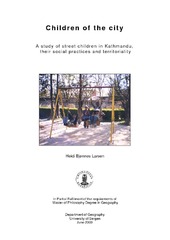| dc.contributor.author | Larsen, Heidi Bjønnes | eng |
| dc.date.accessioned | 2006-08-07T12:35:14Z | |
| dc.date.available | 2006-08-07T12:35:14Z | |
| dc.date.issued | 2003 | eng |
| dc.identifier.isbn | 82-8088-240-5 (electronic version) | |
| dc.identifier.uri | https://hdl.handle.net/1956/1592 | |
| dc.description.abstract | There are as many reasons for being on the street as there are street children. Mutual for allthe urchins on the streets of Kathmandu is the city’s significance in their lives. The childrenno longer depend on their family to provide their fundamental needs. The city has becometheir replacement of a variety of functions. It is therefore likely to presume that there is aspecial relationship between the street children and the city.Within Kathmandu the street children choose to stay in different places. Each place offersseveral practices in order to maintain daily life. The gangs socialize new street children intothe practices in the place, including the territorial practices. Through their daily life anddaily routines the street children appropriate place. The street children's territorialexpressions depend on context and who they are interacting with. They exclude other streetchildren from their place in order to defend their resources. The street children are byrepresentatives from mainstream society considered to be abject and on the margin of society.Ironically the mainstream society's fear of abjection and dirt partly empower the streetchildren to appropriate places. | en_US |
| dc.format.extent | 2395566 bytes | eng |
| dc.format.mimetype | application/pdf | eng |
| dc.language.iso | eng | eng |
| dc.publisher | The University of Bergen | eng |
| dc.title | Children of the city. A study of street children in Kathmandu, their social practices and territoriality | eng |
| dc.type | Master thesis | en_US |
| dc.rights.holder | The author | en_US |
| dc.rights.holder | Copyright the author. All rights reserved | en_US |
| dc.subject.nsi | VDP::Samfunnsvitenskap: 200::Samfunnsgeografi: 290 | nob |
